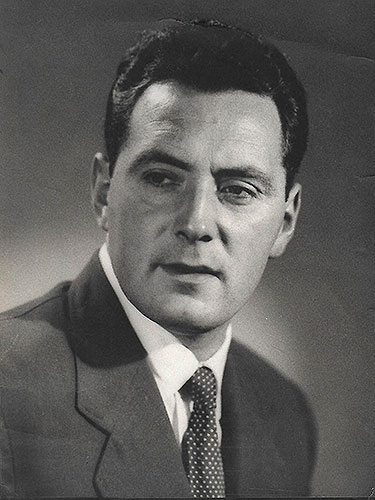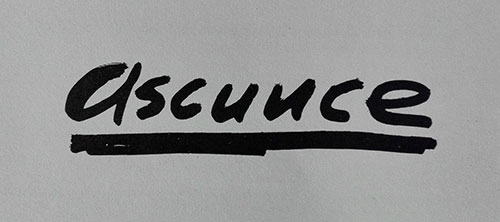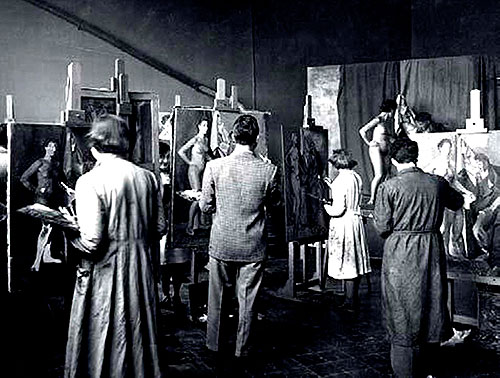The piece of the month of April 2019
THE THRESHING FLOOR, A PAINTING BY JOSÉ MARÍA ASCUNCE
José María Muruzábal del Solar
PhD in Art History
ASCUNCE ELÍA, José María (Beasain, 1923-Pamplona, 1991)
Born in Guipuzcoa of Navarrese ancestry, closely related to the town of Astrain. He began his drawing and painting programs of study , like the vast majority of artists of his time, in the academy of the master Javier Ciga, between 1942-45. The Diputación Foral de Navarra awarded him an economic financial aid so that he could study at the technical school de Bellas Artes de San Fernando in Madrid, where he entered in 1946. There he studied with Valverde, Adsuara and Martínez Vázquez. During the course of the degree program he was awarded prizes and honors, giving him in the subject Landscape, the Pensionado del Paular and the award Drawing from Nature - Carmen del Río Foundation, of the Royal Academy of Fine Arts of San Fernando. At the end of the degree program he obtained the scholarship instituted by the Civil Government of Santander "Pensionado de Santillana del Mar", awarded by the School to the student with the best academic transcript of each promotion.

José María Ascunce in the 1960s.
In November 1952 he was appointed by the Ministry of Education professor of artistic drawing at the School of Arts and Crafts of Corella and, later, secretary of the same center. He remained there, dedicated to artistic education, for more than a dozen years, coinciding with the sculptor Rafael Huerta, with whom he became a great friend. The sculptor himself spoke of Ascunce in this way in the presentation of the anthological exhibition of the Museum of Navarra in 1994:
José María Ascunce was a man of the basin, a man of the look and gesture, of those who watch you and you always think he does not tell you everything he thinks, but not for convenience; they simply do not feel the need to communicate constantly. And I say sobering because, in these times of impudence, in which, to refer only to our guild of art, people cackle before laying the egg, we are sick of seeing young people who do not even know how to mix colors perch, or pretend to make a exhibition. The written life of Ascunce, carried out with depth and time, would be a lesson that should make more than one of us reflect.

signature by José María Ascunce.
In the Painting Contest organized by the City Council of San Sebastian, in October 1957, he won a first prize award with the painting graduate El puerto, a work that today is owned by the City Council of San Sebastian. In September 1958 he was awarded the scholarship for the extension of programs of study of art abroad, instituted by the Diputación Foral de Navarra. With it he studied at the Academy of La Grande Chaumiere in Paris. In October 1965 he was appointed by civil service examination professor of Drawing and Painting at the Municipal School of Arts and Crafts of Pamplona, after the death of Gerardo Sacristán. He held this position until his retirement in 1984. He remained dedicated to the teaching of the Fine Arts in Navarre for more than thirty years, contributing to the training of the most important Navarrese artists of the second half of the 20th century. His disciples make up the Navarrese painting of the last third of the 20th century and the beginning of the 21st century.

Ascunce painting in a class in BBAA of San Fernando (in the center of the back), 1950.
Ascunce made his first individual exhibition in Pamplona, in the dining room of the DFN, in 1950. In 1956 he inaugurated his first individual exhibition in the conference room of García Castañón of the Caja de Ahorros Municipal de Pamplona, where he exhibited regularly for thirty years, coinciding with the times when José María Muruzábal del Val directed the said conference room. He also exhibited in many places in Spain, such as Vitoria, Bilbao, Zaragoza, etc. We can emphasize the exhibition that he developed in the Spanish Society of Friends of the Art of Madrid, together with his friends Jesús Lasterra and César Muñoz Sola, in 1963. He was a member of the committee Navarro de Cultura in 1988. In 1972 he won the first painting award City of Pamplona, with the work entitled Catedral. He was married to Ana María Parada, with whom he had five children.
The work that we present in this work is degree scroll La era, an oil on canvas, measuring 54 x cm. It is a work of the year 1961, dated on the front side next to the signature, which is located at the bottom right. On the back is written by the author himself degree scroll and the signature of the artist. The painting is endowed with a beautiful handcrafted framing of the period, in carved wood and with ironworks. It is currently kept in a well-known collection of Navarrese art, located in the city of Pamplona. The painting was exhibited in the Salones de Cultura de la Caja de Ahorros de Vitoria (1961), issue 21; in conference room Ágora de San Sebastián (1963), issue 21; and in conference room García Castañón, de la CAMP (1963), issue 24.

The threshing floor. Oil on canvas. 1961. Private collection (Pamplona).
José María Ascunce is considered one of the great Navarrese artists of the 20th century. In his work he achieves a special vision of the old villages and the varied landscapes of Navarre, whose singular architectures he traces with a sometimes meticulous drawing and always staff; while he obtains different versions of the fields and the simple land, more profound, agile and schematic. These two styles are born from the adoption of different aesthetic and thematic attitudes. However, still life and portraiture are also very present in his artistic production. This landscape is a good sample of Ascunce's painting, with its great chromatic vision, rich in nuances. The painting, preferably in ochre and yellowish tones, represents a mountainous background, with a country house in the background and occupying a large part of the composition a threshing floor, with two men, a couple of animals and a cart loaded with grain. The painting makes an impact and is endowed with a great sense of expressionism. It is also evident that, with works similar to this one, Ascunce is related to the figurative tradition of Spanish painting, with the great Benjamín Palencia, the second School of Vallecas or the School of Madrid itself, movements that Ascunce came to know first hand.
Ascunce's painting is not subject to academic rigidity. The painting appears endowed with generous impastos with which this artist represents populations and lands, sometimes severe in their realism, sometimes temperamentally expressionist. Before the basically bare land, Ascunce takes an artist's attitude; he strips himself of the anecdotal and interprets the landscape in pure essence, reducing it to its very simplicity. In his paintings the subject is densely used in the fillings that reveal unpainted backgrounds, in addition to the employment of pure black for the profiles. In this work, the figures are almost anecdotal; the landscape, the countryside, the land, the mountain, all this is the soul of the composition. He is an artist who sample has a certain preference for warm colors that he deposits on the canvas almost violently, such as the varied ochers of this painting in question.
SOURCES AND BIBLIOGRAPHY
HUNG, L. M., Estudio sobre José Mª Ascunce (1923-1991): la inspiración en su propia tierra, thesis de Master's Degree, Instituto de Artes Liberales de la Universidad de Navarra, 1994. Unpublished. A copy is kept at file Muruzábal.
MARTÍN CRUZ, S., "José María Ascunce, la voluntad y el tesón de pintar", Pintores navarros II, Pamplona, Caja de Ahorros Municipal de Pamplona, 1982, pp. 8-15.
VVAA., José María Ascunce (1923-1991), sample anthology. Catalog of exhibition in Museum of Navarra, November 1994-January 1995, Pamplona, Government of Navarra.
